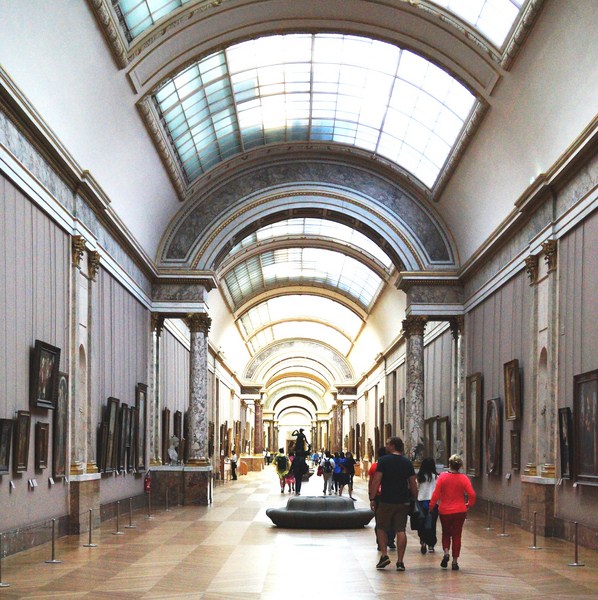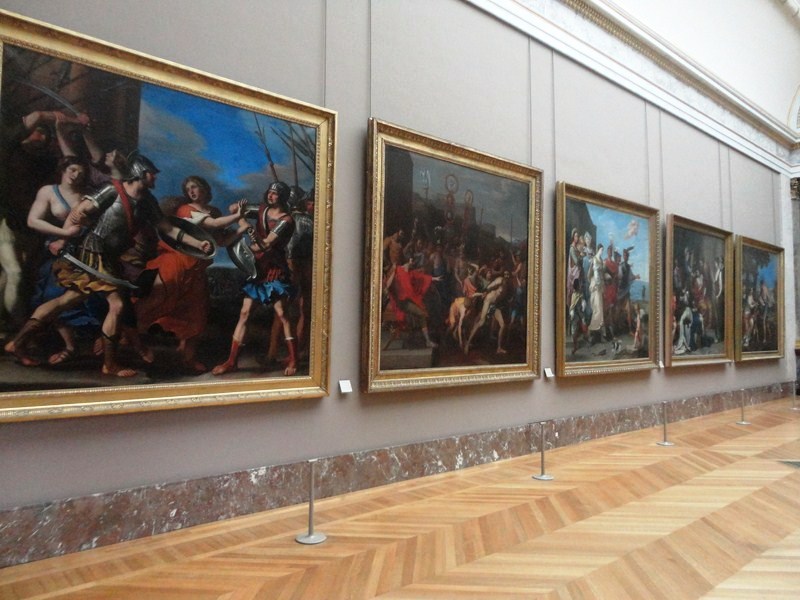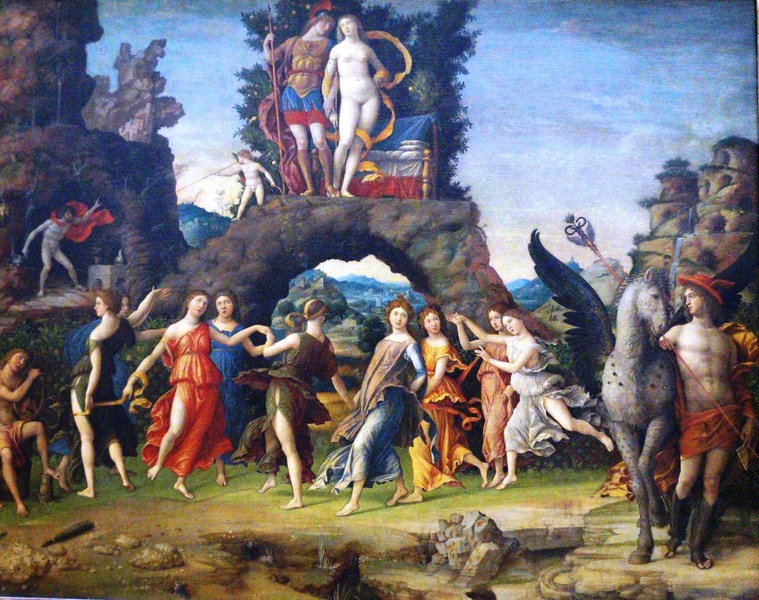The jaw-dropping Grand Gallery (Grande Galerie), built along the River Seine, is one of the most beautiful hallways and the most famous room of the Louvre.
This new piece of the palace was built from 1595 to 1610 by Henry IV, King of France (initially 460 m. long at the time, it was the longest edifice of its kind in the world), which was part of the Grand Dessein he saw completed.
Check out “Louvre Museum – Greek, Etruscan and Roman Department”
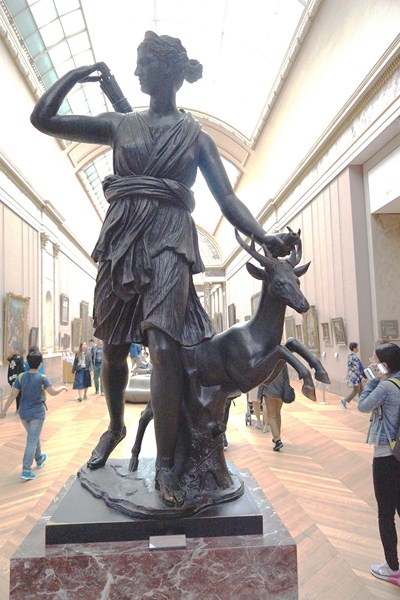
Statue of Diana of Versailles, a partially restored Roman marble copy of a lost Greek bronze original, of the Goddess of the Hunt with a deer, attributed to Leochares ( ca. 325 BC)
When he was a child, future King Louis XIII was playing and initiated to fox hunting there. It wasn’t completed until the reign of Louis XV, about 50 years later. During the 17th century, it was used for the “scrofula ceremony,” during which the Sun King, Louis XIV, laid his hand on the sick.

The author beside The Fortune Teller, a painting by Italian Baroque artist Michelangelo Merisi da Caravaggio, exists in two versions. The first, from 1594, is now in the Musei Capitolini in Rome. The second, from 1595, in the Louvre museum, was painted by Caravaggio for Cardinal Francesco Maria Del Monte. Copied from the original 1594 version, it had certain changes. The undifferentiated background becomes a real wall broken by the shadows of a half-drawn curtain and a window sash, and the figures more completely fill the space and defining it in three dimensions. The light is more radiant, and the cloth of the foppishly-dressed boy’s (model is believed to be Caravaggio’s companion, the Sicilian painter Mario Minniti) doublet and the gypsy girl’s sleeves more finely textured. The dupe becomes more childlike and more innocently vulnerable, the girl less wary-looking, leaning in towards him, more in command of the situation. Close inspection of the painting reveals what the young man has failed to notice – the girl is removing his ring as she gently strokes his hand while reading his palm.
On November 8, 1793, in the midst of the Reign of Terror, the Musee Central des Artes was created and the Grande Galerie was officially opened.
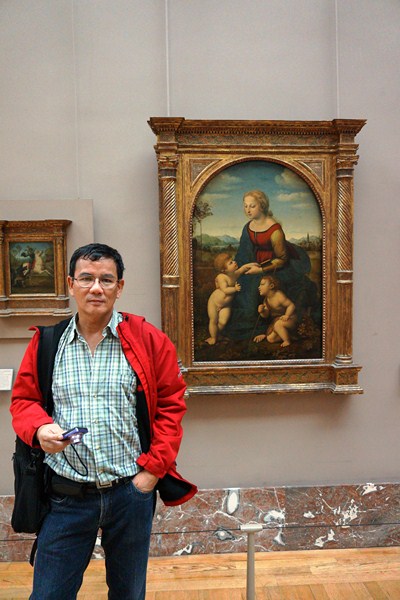
La Belle Jardinière, also known as Madonna and Child with Saint John the Baptist, painted by the Italian High Renaissance artist Raphael during his stay in Florence between 1507 and 1508, was commissioned by the Sienese patrician Fabrizio Sergardi and shows Mary, Christ and the young John the Baptist. Raphael’s use of contrasting light and dark, and the relaxed, informal pose of the Madonna illustrates Leonardo da Vinci’s influence. Because of the harmony and balance of the picture together with the high quality of elements present, this 48 in × 31.5 in (122 cm × 80 cm) paintings is one of Raphael’s famous works.
During the reign of Louis XVI of France (1754-1793), this gallery was planned to be the location of the future royal “Museum.” Charles-Claude Flahaut de la Billaderie, comte d’Angiviller, helped build and plan the Grande Galerie and continued to acquire major works of art.
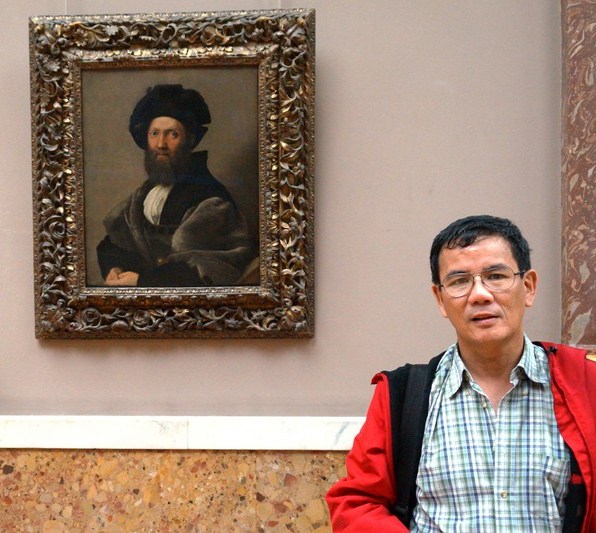
The author beside the Portrait of Baldassare Castiglione, another oil painting attributed to Raphael (1514–1515), is considered one of the great portraits of the Renaissance and has an enduring influence. It depicts the diplomat and humanist Baldassare Castiglione, Raphael’s friend, who is considered a quintessential example of the High Renaissance gentleman. The painting was acquired by Louis XIV in 1661 from the heirs of Cardinal Mazarin.

The Virgin of the Rocks (sometimes called the Madonna of the Rocks), a painting by Leonardo da Vinci, shows the Madonna and Child Jesus with the infant John the Baptist and an angel, in a rocky setting which gives the painting its name. This painting is regarded as a perfect example of Leonardo’s “sfumato” technique.
For many years, the area beneath the Grande Galerie served as artists’ studios and workshops. The engaged columns along the sides were added during the Empire by Charles Percier and Pierre-Francois-Leonard Fontaine, Napoleon I’s favorite architects.
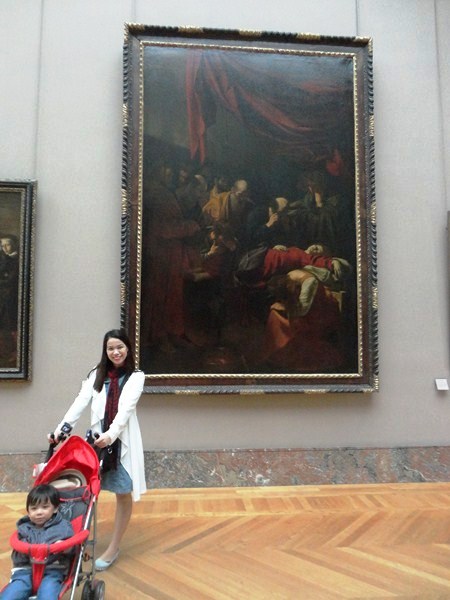
Cheska and Kyle beside The Death of the Virgin, a painting completed by Italian Baroque master Caravaggio in 1606, was commissioned by papal lawyer Laerzio Cherubini for his chapel in the Carmelite church of Santa Maria della Scala in Trastevere, Rome . The figures are nearly life-sized. The Virgin Mary, the painting’s central theme, lies reclined, clad in a simple red dress. Caravaggio completely abandons the iconography traditionally used to indicate the holiness of the Virgin. Her cast-off body, with lolling head, hanging arm and swollen, spread feet, depict a raw and realistic view of the Virgin’s mortal remains, with nothing of the respectful representation found in devotional paintings.
Shortened by a third during the Second Empire to build the Flore Wing, it now houses collections of Italian painting dating back to around the 13th century (1250-1800).
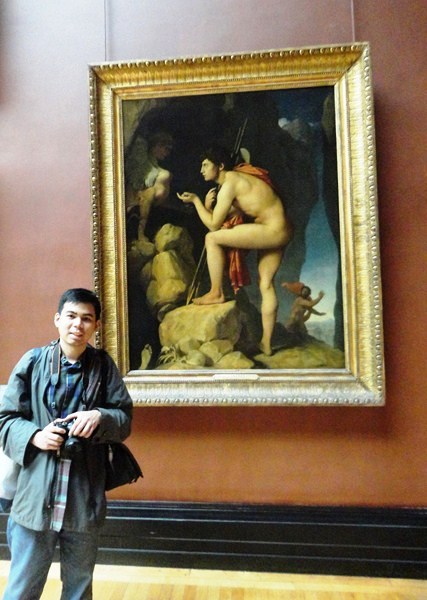
Jandy beside Venus and Cupid with a Satyr (c. 1528), a 5 cm. × 125.5 cm. (74.2 in. × 49.4 in.) painting by the Italian late Renaissance artist Antonio Allegri da Correggio, depicts Venus sleeping with her son Eros. Behind them, a satyr is caught while discovering the goddess.
The Great Gallery now houses one of the world most prestigious Italian Renaissance painting collection, from the Quattrocento (early Italian Renaissance) to High Renaissance and Mannerism with masterpieces of the most famous artists such as:
- Allegory of the Vice, Allegory of the Virtues, Venus, Cupid and a Satyr, and Mystic Marriage of Saint Catherine of Alexandria with Saint Sebastian by Antonio da Correggio
- Autumn (1573), The Four Seasons (1573), Spring (Arcimboldo, 1573), Winter (1573) and Summer (1573) by Arcimboldo
- Portrait of Alof de Wignacourt, The Death of the Virgin and The Fortune Teller by Caravaggio
- Fishing, Hunting, Resurrection of Christ and The Virgin Appears to Saint Luke and Saint Catherine by Annibale Carracci; Big Holy Family, John the Baptist, Portrait of Baldassarre Castiglione and St. Margaret by Raphael; Noli Me Tangere, The Holy Family with St Anna and the Infant St John the Baptist and Portrait of a Man Holding a Statuette by Agnolo Bronzino
- Annunciation by Giorgio Vasari
- Charity by Andrea del Sarto
- Christ among the Doctors by Giovanni Serodine
- Circumcision by Federico Barocci
- David and Goliath by Daniele da Volterra
- The Incredulity of Saint Thomas by Francesco Salviati
- Les Mystères de la Passion du Christ by Antonio Campi
- St. Michael Vanquishing Satan and Self-portrait with a Friend by Raffaello Sanzio
- Madonna and Child Adored by Saints John the Baptist, Francis of Assisi and Catherine of Alexandria by Peter Candid
- The Triumph of David by Bartolomeo Manfredi
- Madonna and Child Appearing to St. Hyacinth by Lodovico Carracci
- Madonna and Child with Saint Anna and Four Saints and Portrait of a Jeweler by Jacopo Pontormo
- Madonna and Child with St. Elisabeth and the Infant St. John by Andrea del Sarto
- Madonna in Glory with St. John the Baptist and St. Stephan by Michelangelo Anselmi
- Moses Rescued from the Nile by Niccolò dell’ Abbate
- Mystic Marriage of St. Catherine by Parmigianino
- Pietà by Rosso Fiorentino
- The Rape of Proserpina by Niccolò dell’ Abbate
- Riposo Durante la Fuga in Egitto by Orazio Gentileschi
- The Circumcision by Giulio Romano
- Venus and Adonis by Luca Cambiaso
- Venus Led by Cupid to the Dead Adonis by Jacopo Bertoia
- The Virgin Appearing to St. Luke and St. Yves by Jacopo Chimenti;
- Visitation by Sebastiano del Piombo;
- David with the Head of Goliath by Guido Reni;
- Ceres by the Raphael workshop
- Saint Francis Receiving the Stigmata by Giotto
- Venus and the Three Graces Presenting Gifts to a Young Woman by Sandro Botticelli
- Saint Sebastian by Andrea Mantegna
- Saint Anne by Leonardo da Vinci
- Saint Michael Slaying the Devil by Raphael
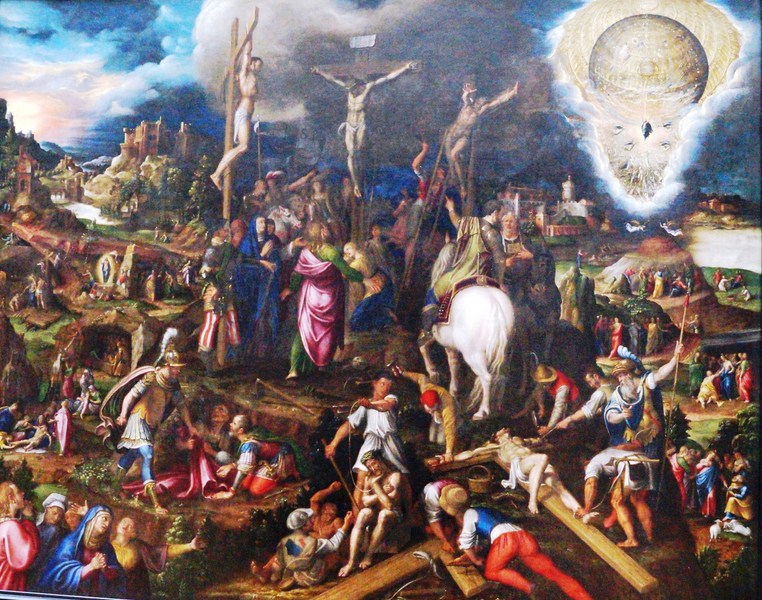
Mysteries of Christ’s Passion (Les Mystères de la Passion du Christ) , by Italian Renaissance painter Antonio Campi, is an oil on canvas created in 1569
This was a gallery that we “saw” quickly in a rush on our way to the State Room (Salle des Etats) to see the Mona Lisa on her stand alone wall. Later, Jandy and I would explore the Grand Gallery in detail.

Portrait of Baldassare Castiglione, another oil painting attributed to Raphael (1514–1515), is considered one of the great portraits of the Renaissance and has an enduring influence. It depicts the diplomat and humanist Baldassare Castiglione, Raphael’s friend, who is considered a quintessential example of the High Renaissance gentleman. The painting was acquired by Louis XIV in 1661 from the heirs of Cardinal Mazarin.
Divided into two by a central tribune, this immense hall originally connecting the Louvre to the Tuileries Palace and is more than a quarter of a mile long and one hundred feet wide.
Check out “Louvre Museum – The State Room“
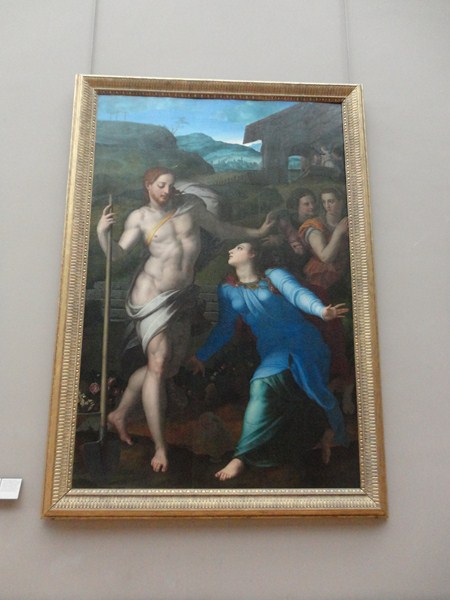
Noli Me Tangere by Agnolo Bronzino, an 289 cm. (113.7 in.) by 194 cm. (76.3 in.) oil on poplar wood, was created in 1561 in the Mannerism (Late Renaissance) style.
Louvre Museum: 75001 Paris, France. Tel: +33 1 40 20 50 50. Open daily, except Tuesdays and holidays, 9 AM- 6 PM (until 10 PM on Wednesday and Friday evenings).
The Louvre has three entrances: the main entrance at the pyramid, an entrance from the Carrousel du Louvre underground shopping mall, and an entrance at the Porte des Lions (near the western end of the Denon wing).
Admission is free, from October to March, on the first Sunday of every month. Still and video photography is permitted for private, noncommercial use only in the galleries housing the permanent collection. The use of flash or other means of artificial lighting is prohibited. Photography and filming are not permitted in the temporary exhibition galleries.
How To Get There: the Louvre can be reached via Metro lines 1 and 7, station Palais Royal – Musée du Louvre Métro or the Louvre-Rivoli stations. By bus, take No. 21, 24, 27, 39, 48, 68, 69, 72, 81, 95 as well as the touristic Paris l’Open Tour. By car, there is an underground parking reachable by Avenue du Général Lemonier, every day from 7 AM – 11 PM.

